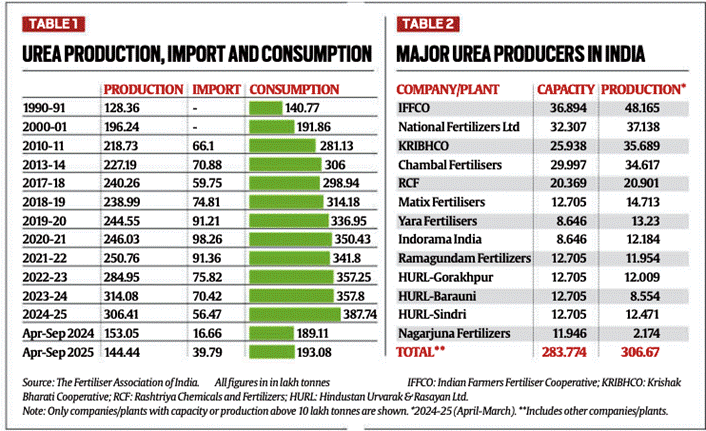Why in News ?
- India’s urea consumption is projected to reach 40 million tonnes in 2024–25, while domestic production has stagnated around 28–29 million tonnes, leading to growing dependence on imports.
- This widening demand-supply gap threatens fertiliser availability and fiscal stability due to high subsidies and price control distortions.
Relevance:
- GS-3 (Economy | Agriculture | Energy):
• Fertiliser pricing, subsidies, and fiscal burden.
• Agricultural productivity, soil health, and balanced fertilisation.
• Dependence on imports and its impact on energy security. - GS-3 (Environment):
• Nitrogen cycle disruption and greenhouse gas emissions (N₂O).
• Sustainable agriculture and nutrient management.

Basic Facts
- Commodity: Urea – nitrogen-based chemical fertiliser.
- Control: Price-controlled under Essential Commodities Act, sold at a fixed MRP (₹5,360/tonne), unchanged since May 2015.
- Producers: Primarily IFFCO, NFL, Chambal Fertilisers, RCF, KRIBHCO, HURL units.
- Regulator: Department of Fertilisers (Ministry of Chemicals & Fertilisers).
Current Situation
- Consumption (2024–25): ~39.9 MT
- Domestic Production: ~28.1 MT
- Imports: ~11.7 MT (≈30% of total requirement)
- Urea Sales Growth: 3.8% YoY (2024–25), highest since 2021–22.
- Table Trend (1990–2025):
- 1990–91: 12.8 MT
- 2010–11: 26.5 MT
- 2024–25: 39.9 MT → Tripled in 3 decades
- Production Growth: Stagnant; increased only marginally despite new plants.
Key Reasons for Rising Demand
- Price Distortion:
- Urea is cheaper than other fertilisers (like DAP, MOP, NPK).
- Current MRP (₹5,360/tonne) vs cost of production/import (~₹24,000/tonne).
- Farmers overuse urea due to affordability, ignoring balanced nutrient use.
- Agronomic Expansion:
- Expansion in wheat, mustard, potato, and rabi acreage post-monsoon.
- Government’s push for higher foodgrain output and irrigation coverage.
- Low Price Elasticity:
- Even minor increases in crop area or yield goals sharply raise urea demand.
Domestic Production Constraints
- Despite commissioning five new plants (Ramagundam, Gorakhpur, Sindri, Barauni, Talcher) between 2021–23,
total output stagnated due to:- Operational delays and technical issues.
- Limited gas availability.
- Ageing capacity at older units.
- Total capacity: ~28.3 MT vs production: ~30.6 MT (2024–25, including overruns).
Dependence on Imports
- India remains world’s 2nd largest urea importer (after Brazil).
- Major import sources: Oman, Saudi Arabia, Egypt, Russia.
- Imports costly due to global price volatility, freight, and rupee depreciation.
- FY25 import bill for urea likely >₹70,000 crore, adding to fertiliser subsidy burden.
Subsidy Burden
- Total fertiliser subsidy (2024–25): ~₹1.9–2 lakh crore.
- Urea alone accounts for ~₹1.3 lakh crore (≈70%).
- Since MRP is fixed, the Centre bears the full differential between cost and selling price.
- Rising imports + high energy costs = severe fiscal strain.
Economic Implications
- Fiscal Stress: High subsidy outlay reduces fiscal space for infrastructure or social spending.
- Nutrient Imbalance:
- Ideal N:P:K ratio = 4:2:1
- Current usage ~8:3:1, leading to soil degradation and declining productivity.
- Import Vulnerability: Dependence on external markets threatens food security if supply chains are disrupted.
- Subsidy Inefficiency: Benefits disproportionately flow to large farmers; not directly targeted.
Policy and Reform Options
- Rationalise Urea MRP:
- Gradual increase to reflect part of actual cost.
- Reduce overuse and encourage balanced fertilisation.
- Promote Nutrient-Based Subsidy (NBS):
- Currently applied only to non-urea fertilisers.
- Inclusion of urea under NBS to promote parity and efficiency.
- Direct Benefit Transfer (DBT):
- Link subsidies directly to farmers rather than fertiliser companies.
- Enhance Domestic Production:
- Fast-track gas allocation and operational stabilisation of HURL and Talcher units.
- Incentivise private sector investment.
- Encourage Alternatives:
- Use of nano urea, organic and biofertilisers.
- Soil Health Card–based nutrient planning.
Broader Context
- Agricultural Sustainability: Overuse of urea depletes micronutrients, acidifies soils, and lowers yields.
- Climate Concerns: Nitrous oxide emissions from excess nitrogen fertilisation contribute to greenhouse gases.
- Energy Dependence: Urea plants are gas-intensive; India imports ~50% of its natural gas.



